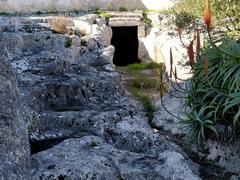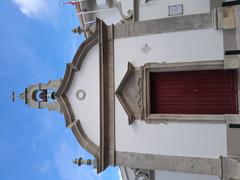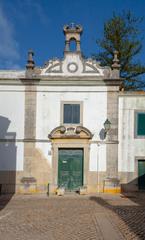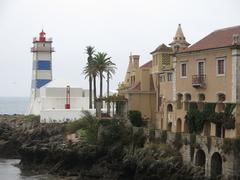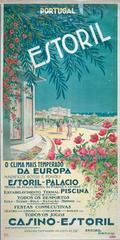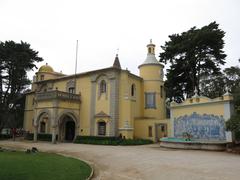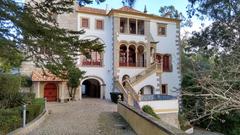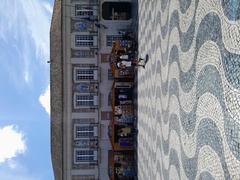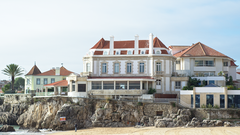Edifício na Avenida das Acácias: Visiting Hours, Tickets, and Estoril Historical Sites Guide
Date: 14/06/2025
Introduction
Nestled in the elegant coastal town of Estoril, Portugal, the Edifício na Avenida das Acácias (also known as Vila Ralph) stands as a testament to the region’s architectural evolution and social history. This guide provides a comprehensive overview of the building’s origins, distinctive Art Nouveau and modernist features, and practical visitor information. Additionally, it highlights the surrounding neighborhood’s rich cultural fabric, including the revitalized Edifício Cruzeiro, now a prominent performing arts academy. Whether you are an architecture enthusiast, cultural explorer, or casual visitor, this guide aims to enrich your understanding and experience of Estoril’s unique heritage (Cascais Cultura; Monumentos SIPA; Idealista; NiT).
Historical Background
Origins and Early 20th Century Context
Constructed in 1899 for James Gilman—owner of the renowned Fábrica de Loiça de Sacavém ceramics factory—the Edifício na Avenida das Acácias epitomizes Monte Estoril’s transformation into a fashionable seaside retreat for Lisbon’s elite. Designed by architect Gaston Landeck, the villa’s construction coincided with the expansion of the Lisbon-Cascais railway, which catalyzed the proliferation of grand residences throughout the area (Cascais Cultura; All About Portugal).
Evolution and Heritage Status
Over more than a century, the villa has retained its residential function while gaining recognition as a Monument of Municipal Interest (Decreto n.º 45/93, de 30/11) due to its remarkable tilework and historical value. The building reflects both the aesthetic sensibilities and societal shifts of its era, bridging the ornate tastes of the late 19th century with the functionalist trends of the 20th (Cascais Cultura).
Architectural Features
General Layout and Structure
The villa is a four-story, rectangular structure with a complex roofline of three- and four-pitched sections, combining form and function to withstand the Atlantic climate. Its walled estate provides privacy, while the mature acacia trees along the avenue add to its serene ambiance (All About Portugal).
Art Nouveau Tilework
A signature element is the exquisite arte nova (Art Nouveau) tilework, likely produced by the Fábrica de Loiça de Sacavém. These azulejos feature intricate floral and geometric motifs, showcasing Portuguese ceramic artistry and the owner’s industrial heritage.
Façade and Ornamentation
The façade features large windows, balconies with wrought iron railings, sculpted stone trim, and decorative cornices. The grand entrance is framed by pilasters and capped with a pediment, reflecting an eclectic blend of Art Nouveau and Portuguese architectural traditions.
Integration with Surroundings
The villa’s integration with the tree-lined Avenida das Acácias and its masonry walls and iron gates underscore its harmony with the landscape and the avenue’s refined character.
Preservation and Current Status
Today, the villa is a protected private residence listed in the SIPA national heritage database. While the interior is not open to the public, architecture enthusiasts and visitors can admire its exterior and the surrounding historic streetscape (Wikimedia Commons).
Architectural and Social Significance
Design and Style Evolution
The Edifício na Avenida das Acácias stands as a bridge between traditional Portuguese design and mid-20th-century modernism. Its clean lines, geometric forms, restrained decorative palette, and functional orientation along the avenue reflect shifts in architectural trends, particularly the International Style’s influence during the 1950s and 1960s (Monumentos SIPA).
Materials and Construction
Reinforced concrete and durable materials such as stucco and painted plaster protect the building from the maritime climate. Occasional use of azulejos in common areas subtly references Portugal’s artisanal heritage.
Urban Context
Positioned within one of Estoril’s most prestigious districts, the building’s scale and elegant massing harmonize with neighboring villas and apartment blocks. The avenue itself exemplifies Estoril’s cosmopolitan identity and leisurely sophistication.
Historical and Social Role
During Estoril’s transformation into a sought-after international resort, the villa accommodated affluent families, diplomats, and seasonal visitors. Its communal spaces fostered social interaction and community spirit, mirroring Estoril’s reputation as a cosmopolitan enclave (Monumentos SIPA).
Contribution to Local Identity
Over time, the resident base has diversified, reflecting broader social changes in Portugal. The building continues to serve as a symbol of Estoril’s refined lifestyle and welcoming, international character.
Cultural Context
Integration with Estoril’s Cultural Life
The Edifício na Avenida das Acácias is ideally situated near key cultural venues, including the Estoril Casino, Centro de Congressos do Estoril, and Tamariz Beach promenade (Lonely Planet). Its presence enhances the cultural landscape, and its backdrop has been featured in films, photo sessions, and private art events.
Symbolism and Heritage
While not a national monument, the building is protected locally and forms part of Estoril’s architectural heritage. Municipal guidelines encourage preservation of original features, maintaining the neighborhood’s historic fabric.
Influence on Contemporary Architecture
The villa’s functional elegance, environmental integration, and focus on communal living continue to inspire new residential developments in Estoril and Cascais.
Practical Visitor Insights
Visiting Hours and Entry
Edifício na Avenida das Acácias is a private residence. There are no public visiting hours, entrance fees, or guided tours of the interior. Visitors may freely view and photograph the exterior from Avenida das Acácias at any time.
Accessibility
The avenue is pedestrian-friendly, with well-maintained sidewalks and accessible public transportation nearby. The building is visible from the street, and the area is generally accessible for those with mobility challenges (Lonely Planet).
Etiquette and Safety
Visitors are encouraged to respect residents’ privacy, keep noise to a minimum, and observe local customs such as greeting neighbors. Estoril is very safe, but standard precautions against petty theft should be observed.
Amenities and Surroundings
While the building itself is residential, the surrounding neighborhood offers a range of amenities—cafés, restaurants, boutique shops, and leisure services. Serviced apartments and hotels are available nearby for those seeking accommodation.
Environmental Considerations
Sustainability practices such as recycling and energy conservation are encouraged throughout the area.
Location & Getting There
By Train
Estoril station on the Lisbon-Cascais railway is a 10-minute walk from Avenida das Acácias. Frequent trains run from Lisbon’s Cais do Sodré station (Cascais Portugal Tourism).
By Car
Accessible via the A5 motorway from Lisbon. Parking is available but may be limited in peak season.
By Taxi or Rideshare
Taxis and rideshare services such as Uber connect Estoril with Lisbon and Cascais at reasonable rates.
On Foot and By Bicycle
Estoril is highly walkable. Bicycle rentals, including free “Bicas” bikes, are available for exploring the coastline (Sintra Cascais Sesimbra Guide).
Nearby Attractions
- Praia do Tamariz: Main beach with golden sands and lively bars (Cascais Portugal Tourism).
- Casino Estoril: Europe’s largest casino, rich in history and entertainment (Tourist Places Guide).
- Estoril Promenade: Scenic walk from Estoril to Cascais, lined with beachside restaurants.
- Palácio Estoril Hotel: Historic hotel known for its architecture and celebrity guests (Tourist Places Guide).
- Estoril Golf Club: Historic seaside golf course (Sintra Cascais Sesimbra Guide).
- Fort of Santo António da Barra: 17th-century fort with panoramic views (Tourist Places Guide).
- Museu Condes de Castro Guimarães: Art and history museum in Cascais.
- Paula Rego Art Gallery: Showcasing works by the acclaimed Portuguese artist (Estoril Portugal Guide).
Dining, Shopping, and Events
Avenida das Acácias and its surroundings offer diverse dining—from traditional bakeries to fine seafood restaurants—and boutique shopping. Estoril hosts annual events such as the Millennium Estoril Open tennis tournament and summer cultural festivals (Estoril Portugal Guide).
Accommodation
While the Edifício itself is not open to guests, the area features luxury hotels (e.g., Palácio Estoril), boutique guesthouses, and serviced apartments. Book ahead for peak seasons (Cascais Portugal Tourism).
Frequently Asked Questions (FAQs)
Q: Can I visit inside Edifício na Avenida das Acácias?
A: No, it is a private residence; the exterior can be admired from the street.
Q: Are there guided tours?
A: Not of the building itself, but local walking tours often include the avenue and other historic sites.
Q: How do I get there?
A: By train (Estoril station), car, taxi, or bicycle from Lisbon or Cascais.
Q: What are the best nearby attractions?
A: Tamariz Beach, Casino Estoril, Palácio Estoril Hotel, and the Edifício Cruzeiro.
Edifício Cruzeiro, Monte Estoril: History, Visiting Hours, and Cultural Significance
Introduction
A short stroll from Edifício na Avenida das Acácias, the Edifício Cruzeiro is a Monte Estoril landmark, recently revitalized as the Academia de Artes do Estoril—a thriving hub for the performing arts (Idealista; NiT).
Historical and Cultural Context
Inaugurated in 1951 as Portugal’s first shopping center, Edifício Cruzeiro became a vibrant social nucleus, featuring shops, a cinema, dance halls, and more. After decades of decline, the building was saved from demolition and acquired by the Cascais City Council in 2016.
Rehabilitation and Modern Role
Reopened in 2023 after extensive restoration, Edifício Cruzeiro now houses the Escola Profissional de Teatro de Cascais, the Conservatório de Música e Dança de Cascais, and Companhia de Dança Paulo Ribeiro—making it a leading center for the performing arts.
Visiting Information
- Hours: Tuesday–Sunday, 10:00–18:00. Closed Mondays and holidays.
- Tickets: Event prices range from €5–€15; some exhibitions and the library are free.
- Guided Tours: Available by appointment.
- Accessibility: Fully wheelchair accessible.
- Location: Central Monte Estoril, with easy public transport.
Visuals

Alt text: Front view of Edifício na Avenida das Acácias showcasing its Art Nouveau tilework and ornate façade.
View on Google Maps.
Summary and Visitor Recommendations
Edifício na Avenida das Acácias is not only a silent witness to Estoril’s golden era but also a gateway to exploring the town’s broader architectural and cultural wealth. The building’s blend of Art Nouveau and modernist features, along with its prestigious location, offer visitors a unique window into Portuguese history. Explore the surrounding area’s attractions, join a guided walking tour, and take advantage of digital resources like the Audiala app for an immersive experience (Cascais Cultura; Idealista; Lonely Planet; Cascais Portugal Tourism).
Sources and Further Reading
- Cascais Cultura: Vila Ralph – Edifício na Avenida das Acácias
- Monumentos SIPA: Edifício na Avenida das Acácias
- Estoril Portugal Guide
- Idealista: Edifício Cruzeiro renasce como Academia de Artes do Estoril
- NiT: O icónico Edifício Cruzeiro foi inaugurado como polo artístico
- Lonely Planet: Things to Know Before Traveling to Portugal
- Cascais Portugal Tourism
- Sintra Cascais Sesimbra Guide
- Tourist Places Guide: Top 10 Places to Visit in Estoril
